The popularity of the video game series like Prince of Persia and Assassins creed piqued the people’s interest so much, that movies were made for the people who were still uninitiated. The movies were brilliant masterpieces, of unmatched cinematography & inspiring story. Most of the people were spellbound & enamoured by these imaginary characters of a fictional story. But were the facts that captivated the mind and hearts of all, who experienced this grand visual treat, just fiction? For the right answers, we have to go back many centuries, to a time when indeed unbelievable larger than life assassins of the ancient world lived. A time when bravery of one person, could bring an entire empire to its heels. Rash and brazen acts of these handful of people altered the course of history, tilting the balance of power in the most unlikely direction.
The story of assassins starts almost a millennium back, in a part of the world, which even in the 21st century is an enigma for most people. Just before the first crusades started (around the end of 11th century) in geographical region of Alamut (corresponding to northern area of modern day Iran), a man started an organization, which would stay alive, long after its founders were gone. Hassan I Sabbah was widely liked by many people in the middle east & adjacent areas, who gradually became his followers. The people of this group were Nizari Ismailis, the largest branch of Ismaili Shia (who are the largest branch of Shia Islam). Hassan used to call his followers Asasiyun (people who are faithful to the tenets of the faith), which later gave rise to the western assassin, for actions in which some of the former mentioned, indulged in. Some people also wrongly believe that assassin is derived from Arabic- Hashishin, a derogatory word for drug addict, which enemies accused these people to be.
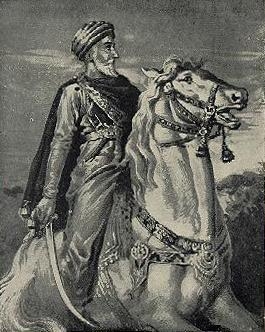
Hassan I Sabbah was was responsible for formation of the Order of Assassins. Hassan I Sabbah along with his secretive group of his followers, formed his base of operations in Alamut mountain fortress in 1090 AD. Here a secret society of deadly assassins was formed by him. The society had strong hierarchical structure, with Hassan as the grandmaster and many subordinates under him, who in turn had many juniors & so on. Some of the most dangerous members (usually of the lowest ranks) indulged in self sacrificing attacks, which continues to remain lethal as “Fidain” attacks. These soldiers were usually young, intelligent, well read (to learn about their enemy’s culture) & trained rigorously in art of war for many years. Soon these dangerous “weapons” were targeted to eliminate key politicians & important generals.
The people targeted for assassination were those who had done great injustice to Ismaili people & their elimination would make life of people, of same faith easier. Usually a single individual was eliminated in public places, to cause intimidation to the enemies. The assassins carrying out these orders were well versed in arts of disguise & war. They were also expert horse riders, which allowed them more options, in mode of attack. These assassins were also used to eliminate religious and political rivals, which allowed establishment of small Nizari Ismaili city state. With time many such small Nizari Ismaili states were formed, strategically on those areas where successful defensive manoeuvres would be possible without suffering much casualty. These small areas were scattered throughout Persia and Syria. So instead of having a continuous landmass under their control, Nizari Ismaili’s area of control were multiple pockets of strongholds, widely surrounded by hostile territories.
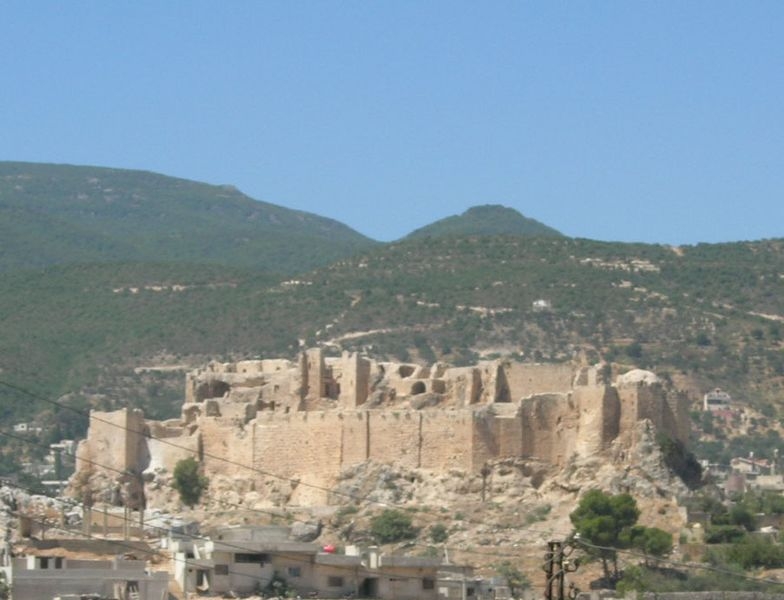
As mentioned Hashshasins attacked their enemies in broad daylight and in public spaces, to create fear in the mind of their enemies. Many times their tactics were designed to only scare their enemies into submission & not kill them. The great Muslim leader – Saladin, who won the 3rd crusade and conquered Jerusalem, for the Islamic forces; was also reportedly humbled by the Hashshasins. Saladin wanted to take over the Masyaf fortress (in north-western Syria) from the local grand master of Hashshasins. But he decided to cancel this idea when he found, a note pinned by a dagger, beside his bed – advising him to withdraw or face death.
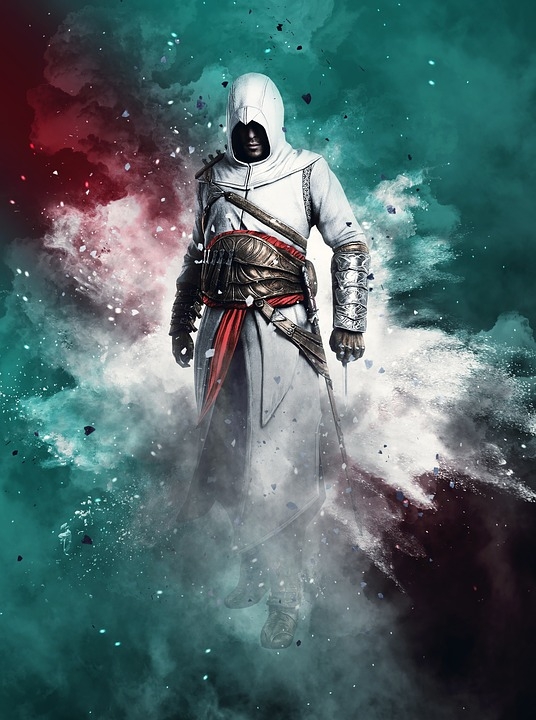
The traditional enemies of Nizari’s were -- Seljuk empire (who were Sunni & hence had religious difference) & the Christian crusading army. Hashshashins were responsible for death of 2 caliphs, and many Sultans, Viziers & crusaders; during their reign of terror. With time their influence, began to decrease as new powers rose in different places. Mongol invaders are one of the most important reason for the end of Hashshashins. Castles in Syria fell to forces of Mamluk Sultanate. In spite of their disappearance from face of the world, their stories slowly spread to the west mostly because of writings of the Italian merchant, explorer & writer – Marco Polo. Their legacy lives on popular culture thanks to fictional movies & video games like – Assassin’s Creed, which show cases Hashshashins conflicts with the elite of Christian crusading army – Knights Templar.
The history of assassination certainly did not start with Hashshasins of Persia, it was just a place where the term “assassin” originated. The means to get rid of an opponent, without fighting a direct battle existed from time immemorial. In the east, the cradle of civilization, another form of eliminating one’s opponent emerged – this one from India. Here science would merge with arts, to give rise to the ultimate femme fatale.

The proponents of Mithridatism believed that a person can be protected from the ill effects of poison, by gradual wilful self administration of sub lethal dose, over a long period of time. The term “Mithridatism” comes from king Mithridates VI, who is believed to have indulged in this practice. But much before the time of Mithridates VI, this art was practised in India. There are clear evidence, of existence of Visha Kanya in ancient India, specially around the time of Alexander the great’s invasion of the western fringes, of the Indian subcontinent. The Visha Kanya, which literally translates to poison maiden; were hand picked beautiful young girls, who were given a diet mixed with a small tolerable amount of, different kind of poisons over a long period of time, which made these women immune to effects of poison, later on.
These beautiful women were used as assassins, by the kings who controlled them. Beautiful unarmed damsels, would never be suspected of any malicious intention- a fact, that was used by their masters to get rid of an opponent, without suffering the ill effects of a direct war. These women were expert in art of seduction, and any physical contact (specially sexual contact) with them, would cause the death of the concerned individual. Sometimes the unsuspecting victim were offered wine, laced with poison. To wipe out doubt from the minds of their enemy, many times these Visha Kanya’s would drink the same drink; but suffer from no harm, but their victims would not be so lucky.

It is believed that, the teacher of Alexander the great – Aristotle cautioned him, about possible attack from Visha Kanya, during his Indian Campaign. Some legends also opine that Alexander the great, died due to effects of poison – with a Visha Kanya being responsible for it. Visha Kanya’s role as assassin, is clearly mentioned in Arthashastra – an ancient Indian written work describing in detail about principles of – economic policy, statecraft and military strategy. This text is of considerable importance, as the person who wrote it – Chanakya, was a very respected teacher of the oldest university of the world – Taxila university, established 2700 years back. Chanakya was also the Guru (teacher) and advisor of the Indian emperor Chandragupta Maurya, who defeated & married the daughter of Seleucus Nicator, who was an infantry general of Alexander the Great and founder of Seleucid empire. With passage of time, luckily or unluckily (depending on perspective) the science behind this art was lost.
Much before the 3rd president of United States of America shared his views as mentioned above, there lived people who were equally conscious about freedom & liberty. The ancient Greek and Roman philosopher’s penchant for social justice was quite well known. The work of Plutarch, Cicero, Seneca, Plato and Aristotle are testimonial of this fact. These scholars had supported Tyrannicide in some form or other. A tyrant is a person of cruel character, who misuses his/her unlimited power – obtained by usurping legitimate sovereignty; assassination of such unjust ruler for betterment of life of common people is known as Tyrannicide.
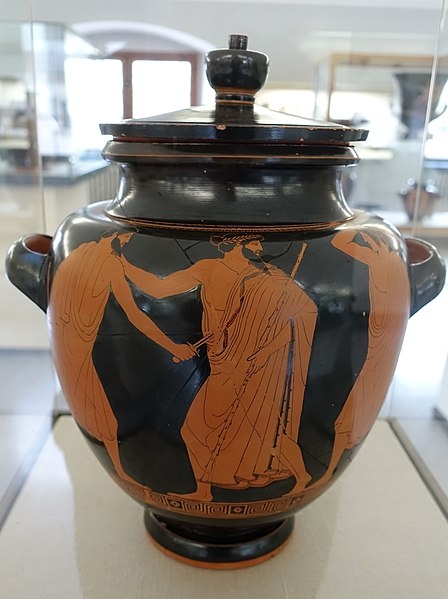
The term first originated in ancient Greece, in year 514 BC, when Hipparchus of Athens was killed by Harmodius and Aristogeiton (who are often called the original Tyrannicides). The details of the event are known, because of the work of the ancient Greek Philosopher Aristotle and historian & general Thucydides. The story begins with Hippias, becoming the tyrant of Athens with support of his brother – Hipparchus, who becomes the minister of culture. Blatant abuse of power by Hipparchus, causes the rise of unpopularity of the brothers, among their subjects. Things changed for worse, when Hipparchus insults Harmodius’s young sister & tarnishes their family name. This enraged Harmodius, who along with his lover Aristogeiton, decides to eliminate the tyrant bothers and restore law of the land. The pair managed to kill Hipparchus but the body guards present, in retaliation killed Harmodius & Aristogeiton was arrested. Hippias the tyrant, who had escaped this assassination attempt, ordered the torture of Aristogeiton & later kills him by his own hands.
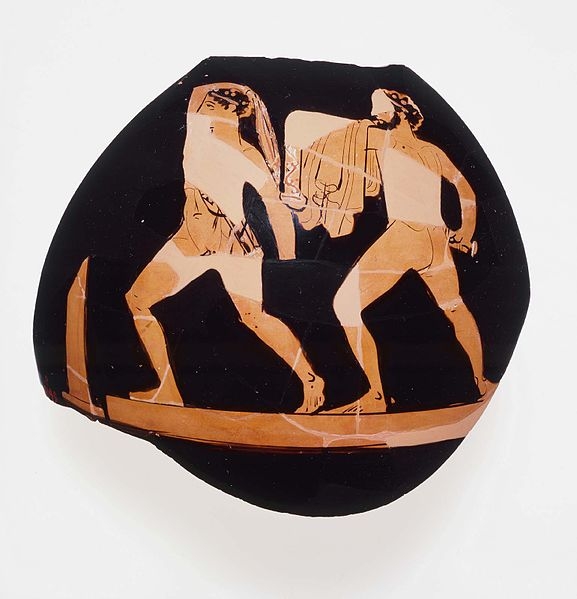
The immediate aftermath of this was the reactionary increase in brutality of Hippias, who was furious because of his brother’s murder. The tyrannical barbarity of Hippias, soon became unbearable, for his subjects & finally he was overthrown from power. Thereafter Harmodius and Aristogeiton became very famous figure among the people, who considered these two as martyrs, who had sacrificed their own life, for greater good. These upholders of Athenian freedom became known as the “Tyrannicides”. For their heroic act, statues of the pair were erected, their descendants were given hereditary privileges and the pair immortalised by songs & other literary creations. Soon the story passed into legend, with people aspiring to be future tyrannicides, to get rid of evil tyrants terrorising the society.
Plato was one of the greatest teachers of Ancient Greece, who had student like Aristotle – who went on to become teacher of Alexander. Plato himself was not just a great philosopher, but also a very ethical and honourable man; but not all of his students were honourable & respected people like Aristotle. This is the story of two such students of Plato, who went on to make, the wrong kind of History. This story is of Dion and his lieutenant – Callippus.
Syracuse is a historic city, on the island of Sicily, in modern day, Italy. In 4th century BC, this area was ruled by a Greek Tyrant – Dionysius I, who had made Syracuse very powerful and prosperous. In this endeavour he was supported tremendously by his wife’s brother – Dion, who acted as advisor to Dionysius I. However, after the death of Dionysius I, his son Dionysius II became the next king. The new king, did not have an amicable relationship with Dion -- his uncle. This created bitter rivalry between the two, and a power struggle ensued. The final result was that Dion emerged as the new, all powerful ruler of Syracuse and Dionysius II was forced into exile.

One of the most trusted aides of Dion was Callippus, also a student of Plato. Although Callippus helped Dion to get in power, but he had his own nefarious intentions. Dionysius II had bribed Callippus to kill Dion and he had accepted the offer. Callippus used his proximity to Dion, to gain his trust and later had him killed in cold blood & he himself became, the ruler of Syracuse. The rule of Callippus lasted only 13 months and was quite unpopular. In a cruel twist of fate, he lost the control of the city & was forced into exile along with some remaining soldiers. With change of fortune of Callippus, the soldiers following him, also began to grow restless and their loyalty grew thin. Soon he was murdered by his own men, reportedly by the same sword, that was used to kill Dion.
Very close to the time when Jesus was preaching about love and universal brotherhood, to attain peace and stability in a place and time, where these words had lost their meaning; a group of religious zealots were trying to get rid of the roman tyrannical rule by a much old fashioned method – by use of brutal force.

Sicarii was the term, given to a group of people living in 1st century AD, who carried “sicae” or small daggers with them. This group of Jews, strongly opposed the Roman dominion of their homeland of Judea. For this purpose, they tried to inflict maximum damage to the Romans & their local supporters. This group of people, so called - “Sicarii” were led by Menahem ben Yehuda and Eleazar ben Ya’ir . Menahem also claimed to be the messiah of Jews, and he believed that best way to liberate the holy land from Romans & their collaborators, was by their assassination. Many times they would attack their victims in public gatherings & later on blend with the local crowd. They also kidnapped their enemies, who would be released only after receiving a ransom. To achieve their own goal, they were also known to destroy the Jerusalem’s food supply, so that the ordinary civilian local population would be forced into a confrontation with their Roman rulers, for their basic survival.
In one of such audacious move, Menahem with his loyal followers, took over the fortress of Masada from the Roman garrison present there. 700 Roman soldiers present were butchered in cold blood. Encouraged by his victory, he also took over another fortress – the fortress of Antonia. Menahem along with his men raided Roman convoys and engaged in guerrilla warfare with their opponents. Their glorious period reached it’s peak when in 66 AD, they took control of Jerusalem, in alliances with other like minded groups. They were known to be very aggressive with those, who challenged their decisions. This frustration against radical & violent methods of Sicarii, culminated in confrontation with other groups, resulting in siege of Temple in Jerusalem in 68 AD.
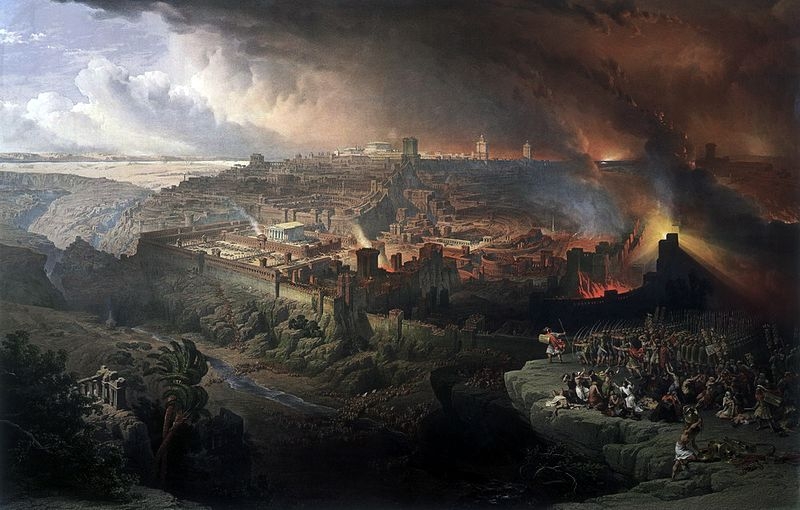
The Romans finally returned to take back the control of the city from the rebels, who had ousted them. The siege created by the Roman’s was meant to starve the rebels. This precarious condition led to disagreement & quarrels among the rebels. In one of such incidents – Menahem, the leader of group was murdered. Soon the Romans would destroy the whole city in 70 AD. Eleazar managed to reach back to the Masada fortress with some loyal followers. They continued with their resistance up to 73 AD, but the Romans surrounded the fort. Rather than submit to the torture and humiliation by the Roman soldiers, all the Sicarii present in the fortress, committed mass suicide, along with their families. By the time the Roman soldiers entered the fortress, the sight of 960 dead bodies lying all around greeted them.
Much before the concept of “Thug Life” caught the imagination and fancy of the western world, it existed as an everyday reality in exactly the opposite part of the world – India, to be precise. Thugs were responsible for approximately 2 million deaths (according to Guinness book of World Records), during their reign of terror, which lasted more than 6 centuries. But who exactly were these Thugs & where did they come from? To get the answers to this question, it would be necessary to take a trip down memory lane, in a country – which was the richest country of the world till the 18th century, when British Imperialism caused irreversible damage to it.
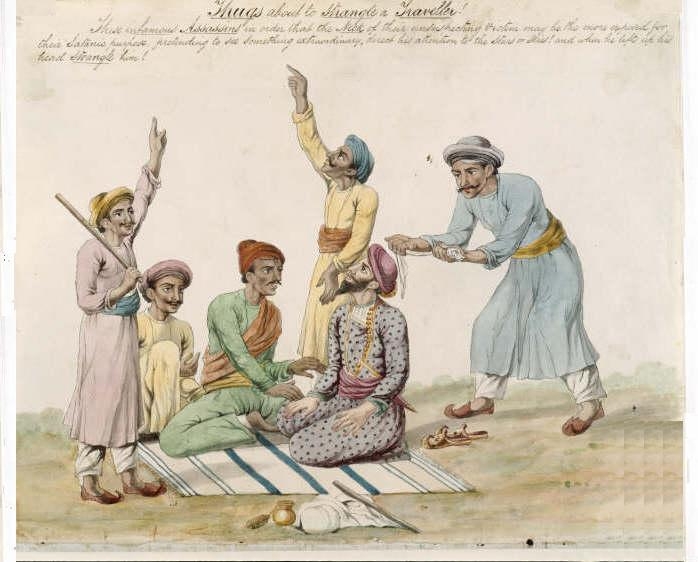
Thugs were the pioneers of one of the first organised crime syndicate in the world. These innocuous looking groups of men were responsible for innumerable robberies and death of their unsuspecting victims. Majority believe that their operations were carried out between 13th to 19th century India, and their existence described in History of Firoz Shah, written by Ziya -ud- Din Barani around 1356 AD. He mentioned about the 1000 thugs being captured in 1290 AD, who were not executed but just exiled, from the borders of Delhi. But Indian philosopher – Bhasarvajna mentioned about “thugs” in his 10th century writings. So it is quite possible that, this ancient group of outlaws may have existed from much earlier times.
Thugs behaved like professional businessmen, and many people chose it as their profession. Most of the members of this criminal fraternity were recruited at a very young age, after obtaining proper training or internship, under an experienced old member of the group. Many time, the young children of the people killed by these thugs were assimilated into the group, who later went on to be active participants. In spite of previously mentioned ways to join the gang, the most common form of becoming a member of the group was always by family relations. Even leadership of many groups were transferred down, from one generation to the next.
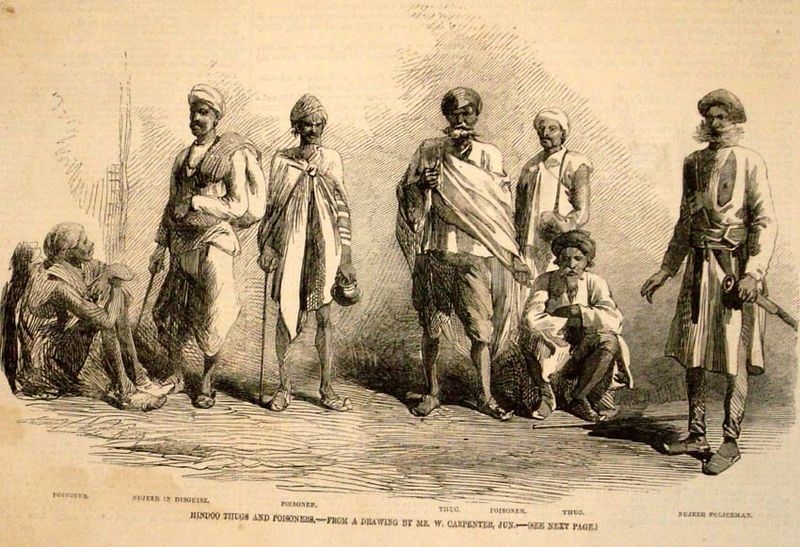
The thugs always targeted a temporary population passing through an area. These were usually merchants travelling through an area & sometimes also pilgrims. The thugs joined these unsuspecting travellers as fellow travellers going to same destination. Slowly with patience & time, they would win their confidence; and kill them when they were resting or sleeping, in an area – considered to be safe by the thugs. Every member of Thug group had a different role. Children were many times taken to these raids, to allay suspicion. Usually small group of people were targeted and the victim chosen was distracted by few people of the group, while another member would attack & strangle the victim from behind and some held the arms & legs of the victim, to prevent them from resisting.
If a larger group was targeted, then small groups of a larger thug group would join the travellers in small numbers – in stages, at periodic intervals. Afterwards they would pretend not to know their fellow thugs, who had joined this group earlier, to avoid suspicion. The thugs would attack the travellers, when the thugs achieved a comfortable majority in this traveller group and reached a location, whose geography was unknown to the travellers, but well known to the thugs.
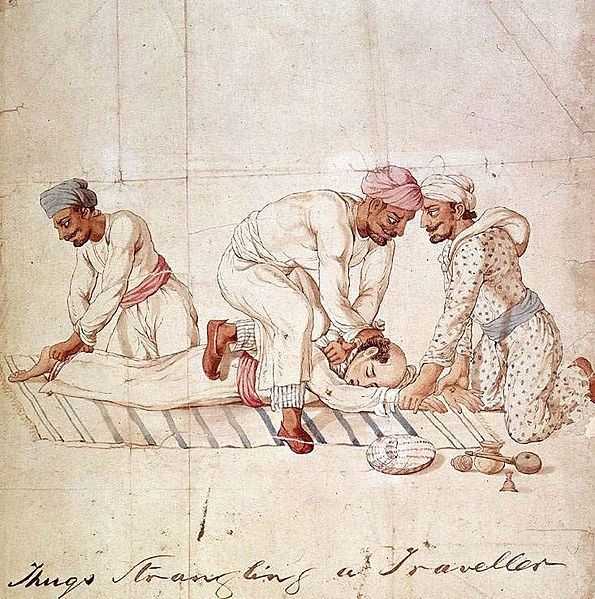
Thug Buhram also known as the king of Thugs, was a leader of a thug group that operated in the North India, in princely state of Oudh. He along with his group were active in late 18th & early 19th century. The name of Thug Buhram has gone down in notoriety, because of the number of people he had killed. It was revealed, that before his hanging in 1840 AD, he had supervised 931 murders of which 125 men were strangled by his own hand. The device used for the strangling process, was an ordinary handkerchief like cloth.
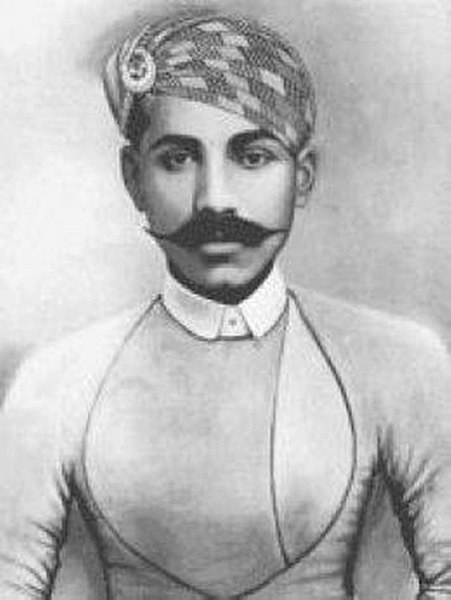
During their time of existence, there were many different groups of Thugs, who were operating in different parts of the Indian subcontinent. The names of the thugee group were derived mostly from their regional background, but sometimes were also derived from their original professions. For many thugs, thuggery was just a seasonal occupation, in which they indulged in, after autumn harvest (October/November) and returning to their villages before monsoon (around June/July). In lieu of bribe & a promise not to hurt the local people, the thugs many times received indirect protection from local administration, who looked the other way, while these criminals indulged in their criminal activities.
The expansion of the British rule in India in 19th century, brought these thugs, under the scanner of British empire. The lawlessness, created by fall of Mughal empire – the last dynasty which ruled the country, created serious law and order problem throughout the nation. The British rule in India, was in its expansive phase & the presence of thugs in the country side, was seen as a challenge by the British authorities in India.
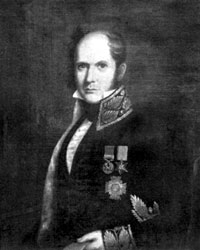
William Henry Sleeman, who was the superintendent of the Thugee and dacoity department (1835 AD) took an active interest in wiping out these antisocial elements. By acquiring detailed information using intelligence agents, many thugs were caught. Some were also turned into government witness and informants, who snitched out others. Thousands of men were imprisoned, executed or expelled. By the 1870s, the Thugs were relegated to stories & legends.
The above stories clearly demonstrated, that crime never pays, at least not in the long run. The historical stories discussed here, disappeared from the minds of people, with the passage of time & later would exist only in certain folklore. As has been said, where history meets myths, legends are born. Legends pertaining to above mentioned people & their groups, still inspire many. Some choose to copy their footsteps for money & sometimes for glory. In a world that encourages everybody to similar conformity & being the same, the above mentioned people stood out from the rest, for their bravery or notoriety, depending on your individual perspective.